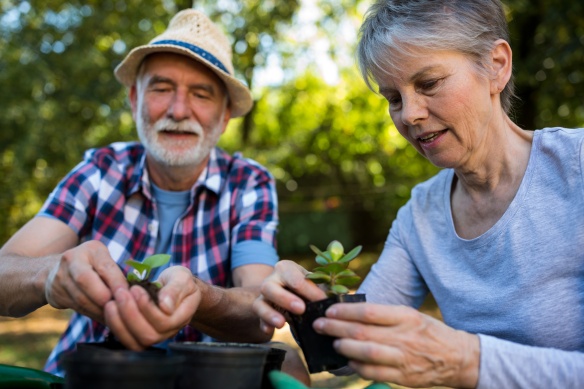
Clipping vegetables and watering flowers can do wonders for the soul and have a profound effect on a stressed physiology. Horticultural therapy is a health-care specialty that uses gardening to promote physical and emotional health by creating a peaceful oasis amid the challenges of Alzheimer’s disease, or any other caregiving situation.
Therapy gardens encourage memory-impaired people and their caregivers to take a moment to smell the roses and perform tasks that magically momentarily take away their cares and worries. You might already being working in the garden, which is a natural balm for these anxiety-filled days.
If you are caregiving for a loved one at home, gardening is a great opportunity for you and your care partner to spend time outdoors, connect through memories that might arise, and de-stress. You’ll also gain the satisfaction of accomplishing something that will, hopefully, provide you with beauty, sweet scents, and/or food!
Here are some ways to include your care partner so that you both benefit—from the “Horticulture Therapy by horticulurual therapist Pam Catlin, chapter 17 in my book “Calmer Waters: The Caregiver’s Journey Through Alzheimer’s and Dementia.
Throughout the ages people have connected over food and the garden setting provides an abundance of taste experiences through edible flowers, herbs, and vegetables. Not all non-poisonous flowers are tasty or have a pleasing texture, however. Some tried and true edible flowers are nasturtiums, lavender, day lilies, roses, tulips, pansies and violas. The flowers can be used in salads, baking, decorating cakes and so much more. In caring for these flowers, chemical pesticides must be avoided.
Herbs and vegetables are a great addition to a garden and they provide another taste experience for the gardener. Examples of easy to grow herbs are basil, chives, mint, oregano, parsley and rosemary. Some are even perennials that will come back each year. These herbs might be enjoyed by being mixed into plain yogurt or softened cream cheese to create an easy dip to spread on a cracker. When selecting vegetables, keep in mind that all of the solanaceous family (tomatoes and eggplant) have toxic foliage. With close supervision, they can still be planted as most gardeners love a beautiful ripe tomato.
For those who have retained their olfactory senses, just running hands over herb plants provides a fragrance to inhale and enjoy. Scented geraniums, grown for their foliage and not their bloom, date back to Victorian times and are now available in most nurseries in a variety of fragrances including but not limited to citrus, chocolate and rose. Particularly fragrant flowers to include in your garden are sweet alyssum, heliotrope, pansies and cosmos.
When selecting plants to stimulate the visual senses, it is important to remember that bright colors such as reds, pinks and yellows are more easily seen by older eyes than subtle, pastel colors or white. Don’t forget interesting leaf patterns when looking for visual stimuli. Unusual leaf patterns and colors can be found in coleus, Rex begonias and some grasses, such as zebra grass.
Consider adding some auditory elements to the garden. Wind chimes near the patio door can assist in orienting an individual to the door’s location. Grasses, trees, plants with seed pods, water features and bird feeders can all add a variety of pleasant sounds to the garden.
As the other senses fade, tactile stimulation becomes an important part of the gardening experience. Selections that are surprisingly soft to the touch are dusty miller, African fountain grass and lamb’s ears. Smooth skinned succulents provide tactile interest and can be grown indoors and (weather permitting) outdoors. Placing plants with texture near the edges of containers or beds is an invitation to garden visitors to touch and feel as they move through the outdoor space. If the gardener with cognitive issues is not responsive to the stimuli when touching with their fingers try running a fuzzy leaf across the cheek. The apple of the cheek is filled with tiny nerve endings that will often be more receptive than the nerve endings in older fingers.
What you need to set up a therapy garden in your yard or porch
As the person with memory loss advances in his or her disease process, physical balance tends to become a challenge. an effective way to create a safe gardening experience is to elevate the growing areas either through raised beds or large ports. For those able to stand for short periods of time, a variety of planter heights would be ideal to support gardening while standing or sitting. rEcommended dimensions for planter height is 2′ – 2 1/2′ for sitting or 3′ – 3 1/2′ for standing. Acceptable dimensions for widths are 2′ if accessible from only one side or 4/ if accessible from all sides.
If the gardener has limited reach, avoid building materials such as bricks or block as it would be difficult to reach the soil to plant. It’s a good idea to measure what would be comfortable for the user before constructing the garden. Growing in pots or raised beds requires good planting mixes (combination of peat moss, topsoil and sand or perlite or a good quality soilless mix), regular fertilizing and plants that are no taller than 3′.
These days, many large pots are lightweight and easy to move andn place prior to filling with soil mix. Pots can be placed on rolling saucers, provided the wheels have brakes, or on pavers to help raise
Successful Plants
There are a number of tried and true plants that are safe for the garden. For cool weather gardening, calendulas, pansies/violas, and stock add bright color. Cool season vegetables are broccoli, cabbage, cauliflower, kale, lettuce, peas, radishes and spinach. Suggested plants for the warm season shade garden are coleus, impatiens, begonias and mint. Good plants for warm season sunny locations would be alyssum, dusty miller, geraniums, marigolds, purple cup flower, petunias, portulaca, snapdragons, zinnias, most herbs other than mint and most vegetables other than those mentioned for cool season planting. Bush varieties of squashes and cucumbers are best suited for raised beds and pots, as are some varieties of tomatoes.
A piece of advice when creating a garden space is to start small. The primary purpose of this growing area is to provide peace of mind and an avenue of connection for the person with memory loss and those providing care, not food production. A garden that provides a balance of physical activity and just being in nature is a perfect addition.

Barbra Cohn cared for her husband Morris for 10 years. He passed away from younger-onset Alzheimer’s disease in 2010. Afterward, she was compelled to write “Calmer Waters: The Caregiver’s Journey Through Alzheimer’s & Dementia”—Winner of the 2018 Book Excellence Award in Self-Help—in order to help other caregivers feel healthier and happier, have more energy, sleep better, feel more confident, deal with feelings of guilt and grief, and to ultimately experience inner peace. “Calmer Waters” is available at Amazon, Barnes & Noble, Boulder Book Store, Tattered Cover Book Store, Indie Bound.org, and many other fine independent bookstores, as well as public libraries.
